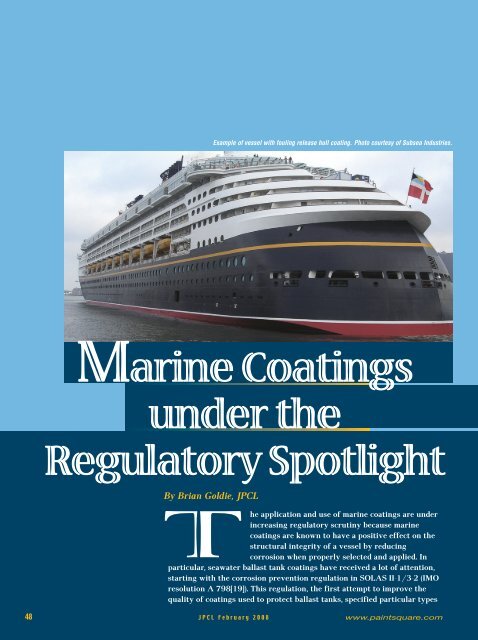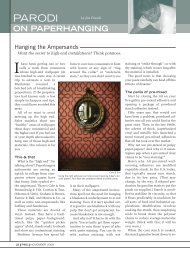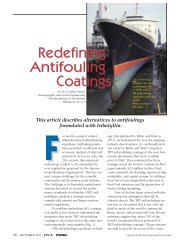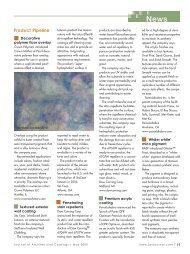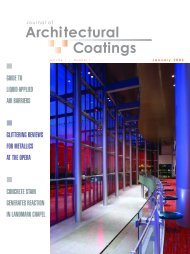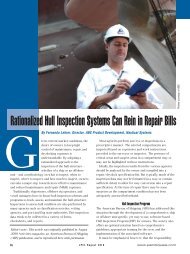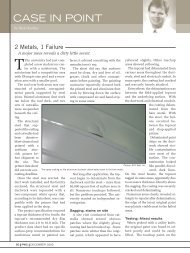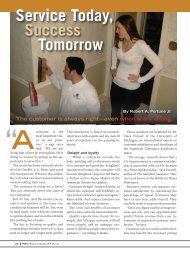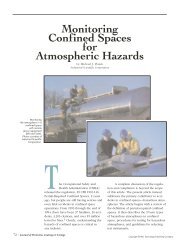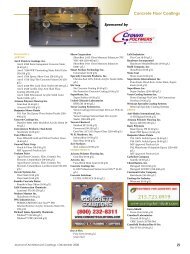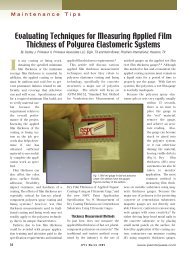Marine Coatings under the Regulatory Spotlight - PaintSquare
Marine Coatings under the Regulatory Spotlight - PaintSquare
Marine Coatings under the Regulatory Spotlight - PaintSquare
You also want an ePaper? Increase the reach of your titles
YUMPU automatically turns print PDFs into web optimized ePapers that Google loves.
of coatings and detailed how <strong>the</strong>yshould be applied to give long lifeprotection. This regulation, however,applied only to bulk carriers andtankers.Building on this start, morecomprehensive regulations andstandards were developed, initially asan industry-led exercise and now with<strong>the</strong> full backing of <strong>the</strong> InternationalMaritime Organization (IMO), resultingin <strong>the</strong> latest regulation, MSC 215(82),<strong>the</strong> Performance Standard forProtective <strong>Coatings</strong> (PSPC). Thisstandard applies to all ships over 500GRT (gross register tonnage) after July1, 2008, and replaces <strong>the</strong> abovecorrosion prevention regulation inSOLAS. However, it also applies to allvessels being constructed afterDecember 8, 2006, <strong>under</strong> <strong>the</strong>InternationalAssociation ofClassificationSocieties (IACS)Common StructuralRules. IACS hasissued ProceduralRequirement (PR 34)on Application of <strong>the</strong>IMO PSPC,Resolution MSC.215(82) <strong>under</strong> IACSCommon StructuralRules for BulkCarriers and OilTankers. PR 34 is to be read inconjunction with PSPC and, <strong>under</strong>IACS, <strong>the</strong> PSPC becomes mandatory. Itdefines <strong>the</strong> IACS verification role, not<strong>the</strong> day to day application andinspection. PR 34 aims to enableuniform <strong>under</strong>standing of IMO PSPCrequirements and will expire on July 1,2008.A fur<strong>the</strong>r regulatory step taken by <strong>the</strong>IMO was to control <strong>the</strong> type ofantifouling hull coatings that can be used.(Above): Example of poorconstruction process.Oil/grease stains (frompower tools) during blockassembly. Photo courtesyof Amtec Consultants Ltd(Left): Example of ballasttank in GOOD condition(~1% breakdown on flatareas, 5-10% breakdownon edges). Photo courtesyof Amtec ConsultantsLtdwww.paintsquare.comJ P C L F e b r u a r y 2 0 0 8 49
Your coating has to be tough enough to stand up to <strong>the</strong> most extreme environmentsimaginable. And <strong>the</strong> most scrutinizing coating inspectors. That’s why Sherwin-Williamsoffers <strong>the</strong> industry’s most complete range of corrosion-resistant coatings and liningsengineered for <strong>the</strong> harshest environments to provide superior protection and minimizecostly downtime.To learn more about our petrochemical coatings, including those with our revolutionaryOptically Active Pigment (OAP) technology, visit us at www.sherwin-williams.com/imor call 1-800-524-5979 to have a representative contact you.©2007 The Sherwin-Williams Company Stop by our booth at NACEsherwin-williams.comClick our Reader e-Card at paintsquare.com/ric
While ballast tank coatingregulations are directedtoward safety andperformance, regulationsfor anti-fouling coatings areenvironmentally driven.This was not a safety/performanceregulation, but an environmental one.The most common biocide used inantifouling coatings was TBT (tri-butyltin), which has been found to be harmfulto non-target marine organisms and <strong>the</strong>marine ecosystem. The anti-foulingconvention was approved in 2001, witha date of entry into service set forJanuary 1, 2008—assuming that it hasbeen ratified by <strong>the</strong> required number offlag states. This required number wasreached in September 2007 whenPanama signed <strong>the</strong> treaty, and <strong>the</strong>convention will enter into force onSeptember 17, 2008. After this date,ships will no longer be permitted toapply or re-apply organotin-basedantifouling systems and may not have<strong>the</strong>se compounds on <strong>the</strong>ir hulls orexternal parts unless <strong>the</strong>y have a barriercoating that will prevent <strong>the</strong> biocidefrom leaching out.It is not surprising that, at a recentLloyd’s List-organized conference onManaging and Preventing <strong>Marine</strong>Corrosion (London, November 21–22,2007), many of <strong>the</strong> presentationscovered aspects of <strong>the</strong> above coatingregulations in relation to <strong>the</strong>irimplementation. These aspects arediscussed below.Ballast Tank <strong>Coatings</strong>and Ship ConstructionIn his presentation, “TheCurrent Problems withBallast Tank <strong>Coatings</strong>.” LesCallow of AmtecConsultants Ltd, discussedhow his experiences withinspecting older vesselsrevealed evidence of howconstruction factors canaffect <strong>the</strong> service lifetimesof ballast tank coatings. Ingeneral, it was evident that• cut edges tend to fail prematurely;• welds tend to fail earlier than flatsurfaces;• areas of burn-through damage failearly;• flat areas are generally <strong>the</strong> last to failby corrosion; and• ballast tank <strong>under</strong> deck areas usuallyfail first.The new IMO regulations aim for a15-year target life, with <strong>the</strong> remainingcoating in good condition. As defined inIACS Rec 8, good means that rust spotson flat surfaces must cover less than3% of <strong>the</strong> area <strong>under</strong> consideration andthat <strong>the</strong>re must be less than 20%breakdown on welds and edges. Thenew regulations aim to achieve <strong>the</strong>selonger coatings lifetimes throughimproved new construction practicesthat address <strong>the</strong> areas of failure notedabove by regulating <strong>the</strong> surfacepreparation and coating application.Marcus Cridland (ABS) describedhow <strong>the</strong> Ballast Tank CoatingRegulations (MSC 215 [82],Performance Standard for Protective<strong>Coatings</strong>, PSPC) were being addressedwithin a classification society and what<strong>the</strong> society is doing to help itscustomers.The ability of coatings to resistcorrosion over extended periods oftime is an important contributor insafeguarding <strong>the</strong> capital investment of avessel. Correctly functioning coatingscan reduce <strong>the</strong> rate of corrosion,<strong>the</strong>reby potentially delaying <strong>the</strong> use ofcorrosion margins in a vessel’sstructural scantlings (dimensions of <strong>the</strong>ship’s structural parts). In recent years,<strong>the</strong> Class Societies have permittedoptimization of scantlings, which hasresulted in thinner steel plates beingused and subsequent reductions inoverall weight of vessels. This meantthat coatings were playing anincreasingly important role, but <strong>the</strong>iruse was unregulated—hence <strong>the</strong> needfor <strong>the</strong> PSPC.The PSPC addresses key points byadopting industry best practices asminimum requirements, setting clearproduction QC standards; imposingexplicit inspection testing andverification; and requiring appropriatedocumentation of production,inspection, and testing activities.General help is contained in <strong>the</strong> ABSGuide for CPS Notation and <strong>the</strong> 3 rdedition of <strong>the</strong> ABS Guidance Notes on<strong>the</strong> Inspection, Maintenance, andApplication of <strong>Marine</strong> Coating Systems,updated to include PSPC requirements.For example, <strong>the</strong>re is a coating processflow diagram, cross referenced to <strong>the</strong>PSPC review steps, and examples oftypical required daily log of records,although it was noted that someinterpretations of <strong>the</strong> Standard stillneed to be debated by IACS.Anti-fouling Regsand Paint Companies’ ResponsesIn response to <strong>the</strong> Anti-fouling SystemsConvention (AFSC), <strong>the</strong> major marinepaint manufacturers voluntarilydecided to withdraw tin-containing50 J P C L F e b r u a r y 2 0 0 8www.paintsquare.com
Click our Reader e-Card at paintsquare.com/ric
antifouling hull coatings from <strong>the</strong>market before <strong>the</strong> IMO conventionenters into force. The EU also passedlegislation that bans <strong>the</strong> application oftin-containing coatings and prohibitsvessels with tin-based antifoulings fromentering EU ports.The paint industry responded to<strong>the</strong>se regulations by fur<strong>the</strong>r developinganti-fouling coating technology basedon o<strong>the</strong>r fouling control mechanisms.The first coating developed usesalternative active species (biocides) informulations similar to <strong>the</strong> banned tinbasedsystems. However, EdwardKleverlaan of IMO, in an update of <strong>the</strong>AFSC, noted that <strong>the</strong> effect of some of<strong>the</strong>se active species on <strong>the</strong> environmentand humans was being studied.The o<strong>the</strong>r new technology is basedon non-stick (fouling release) coatings,and examples of <strong>the</strong>se were given bythree suppliers. Martin Pauwels andMartin Weightman (Subsea Industries)described <strong>the</strong>ir totally non-toxic systembased on a vinyl ester resin containinga high loading of glass platelets. Thissystem can provide a very smooth,tough coating that is effective againstcorrosion and fouling. Fouling does noteasily adhere to this smooth surface,which can be regained by in-waterpolishing to extend lifetime fur<strong>the</strong>r.Torben Rasmussn (Hempel) describeda fouling release coating based onsilicone resin and gave evidence of how<strong>the</strong> coating reduced hull skin frictionand optimized fuel consumption.John Willsher (International Paint)described fouling release coatingtechnology based on silicone resintechnology and <strong>the</strong> latest developmentusing fluoropolymers. Silicone foulingrelease systems contain no biocides,have low surface energy due to a verysmooth, “slippery” surface, and workwell for fast and active vessels.Fluoropolymers are purported tocreate smoo<strong>the</strong>r, tougher coatings withbetter fouling release and staticproperties, and can be used on morevessel types/trading patterns.Challenges: Present and FutureAndrew Alderson, Director TechnicalExcellence Centre, Registro ItalianoNavale, summed up <strong>the</strong> latestregulations and, looking to <strong>the</strong> future,highlighted <strong>the</strong> challenges <strong>the</strong>seregulations raise for <strong>the</strong> coatingsindustry. Alderson is also chairman of<strong>the</strong> IACS Expert Group on <strong>Coatings</strong>and sits on various industry technicalpanels.The PSPC for dedicated seawaterballast tanks in all types of ships anddouble side skin spaces of bulk carriersis prescriptive for <strong>the</strong> types of coatingsand control needed, said Alderson. It isnot, however, a barrier to innovation.Article 5 invites governments toencourage <strong>the</strong> development of newtechnologies and alternative coatingsystems and to keep <strong>the</strong> Organisationadvised of any positive results. Thesealternatives to <strong>the</strong> specified coating caninclude special steels or alternativecoatings (e.g., quick dry).Alderson also raised severalquestions. What about alternatives to<strong>the</strong> inspector or methods of inspection?As required in <strong>the</strong> PSPC, this has alarge resource requirement and is slow.There are quick drying coatingsavailable, but are <strong>the</strong>re quickinspections? Possibilities includeautomated inspection using robots andsmart coatings (self-indicating, opticalcoatings) but how can <strong>the</strong>se bevalidated?Future regulations are <strong>under</strong>way tocover <strong>the</strong> coating requirements in voidsand cargo spaces of oil tankers and for<strong>the</strong> inspection, maintenance and repairof marine coatings. Can we use certifiedcoatings for cargo tank coatings incrude oil tankers? What is <strong>the</strong>composition of <strong>the</strong> crude oil beingcarried and how will <strong>the</strong> ship masterknow if his coatings are compatible?For inspection, maintenance, andrepair, guidelines are being developedbased on IACS Rec 87. The guidelinesfor ships’ staff need to be simple andclear, or do we need qualifiedinspectors onboard?Ano<strong>the</strong>r IMO Regulation is <strong>the</strong>Ballast Water Convention. This is not acoatings regulation, but it impinges oncoating performance or lifetime. Thisconvention aims to stop <strong>the</strong> transportof invasive marine species from onepart of <strong>the</strong> globe to ano<strong>the</strong>r in <strong>the</strong>ballast water by ensuring <strong>the</strong> water istreated before discharge into <strong>the</strong> sea oris discharged into fixed onshorefacilities where it can be treated.Several onboard systems have beendeveloped, but <strong>the</strong> question remains:should <strong>the</strong>se ballast water treatmentprocesses be compatible with <strong>the</strong>prescribed coatings, or should coatingsbe compatible with <strong>the</strong> systems?It is obvious that <strong>the</strong> marine coatingindustry is in a dynamic era, with moreand more regulatory input. This canonly improve <strong>the</strong> performance obtainedfrom coatings, but can this be achievedwithout excessive cost to <strong>the</strong>industry—which negates anyadvantages gained from longerlifetimes? Only time will tell.52 www.paintsquare.comJ P C L F e b r u a r y 2 0 0 8
Click our Reader e-Card at paintsquare.com/ric


